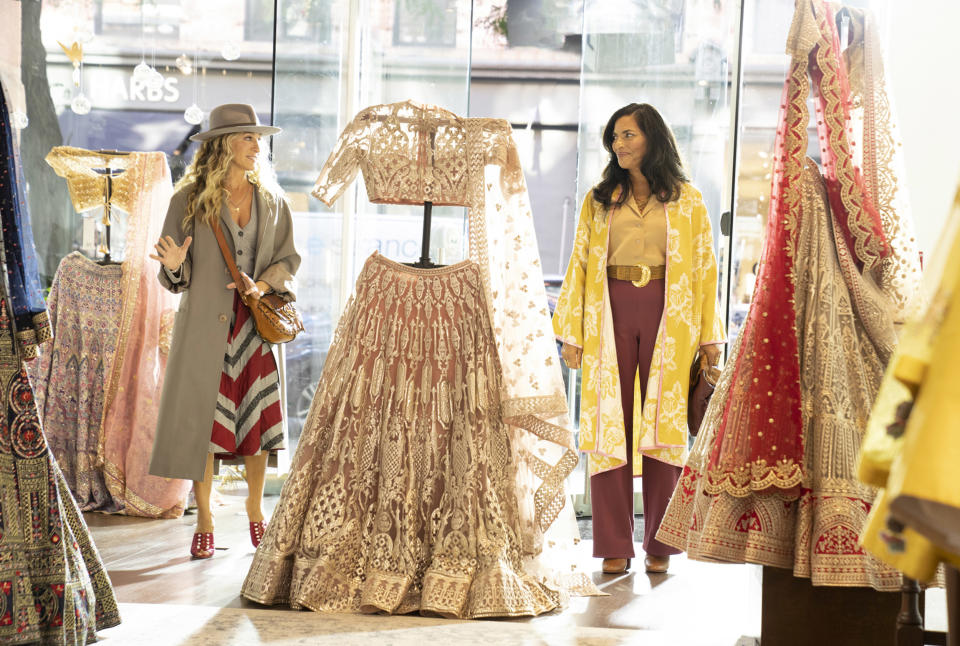Carrie Bradshaw's 'Diwali' outfit is more than a fashion faux pas
- Oops!Something went wrong.Please try again later.
- Oops!Something went wrong.Please try again later.
An image of Carrie Bradshaw carefully descending the stoop of her Upper East Side, New York, apartment — flowers in her hair, donning a red and blue lehenga — turned into a meme over the weekend after “And Just Like That” aired an episode entitled “Diwali.”
Thirty minutes of plot in the “Sex and the City” spinoff series episode culminated in a 88-second Diwali sequence, where Carrie meets the parents of mid-50s, single, Indian real-estate broker Seema Patel (Sarita Choudhury), one of the most recent additions to the cast. Filled with arranged marriage talk and a misunderstanding of what a sari is, the episode fell short for many South Asian viewers.
Seema — who began as Carrie’s realtor, selling her apartment after the death of her husband — got more of her own plotline in the episode. In it, Carrie invites herself to the Patel family’s celebration, and after a go-ahead from Seema about cultural appreciation vs. appropriation, she starts to shop for a sari.
But what she found wasn’t a sari. In fact, there were no saris in the supposed sari shop where Seema took Carrie. As viewers pointed out online, after excitedly mentioning saris several times, Carrie ended up donning an ornate blue and red lehenga.
A critic said Seema herself is a type of character that almost never sees the light of day: a single, middle-aged and purely fabulous South Asian woman who still lies to her parents about who she’s dating and what she’s smoking.

“She steals every scene that she’s in,” sociologist Nancy Wang Yuen, who specializes in race in film, said. “I feel like there’s never enough of her. I’m completely drawn into her story, and I want to know more.”But the storyline focuses on Seema contending with her parents’ desire to arrange her marriage — a stereotype often seen in white media portrayals of South Asian culture — along with her cousin being the doctor Carrie sees for her hip surgery.
“And Just Like That” writers said the episode was meant to be a chance for audiences to get to know the new person, beyond just her friendship with Carrie.
“To kind of poke behind the curtain and see her with her family is always a way to learn what’s behind that exterior,” writer and executive producer Elisa Zuritsky said in an episode of the “And Just Like That” writers’ podcast.
Despite the shortfalls, it’s a contrast from how the show has treated nonwhite characters in the past, critics are pointing out.
People of color featured on the show’s original run and two subsequent movies were seen as background friends, side characters and fleeting love interests, all there to accessorize the main four white women.
Those who saw 2010’s “Sex and the City 2” often point to the infamous scene during the friends' trip to the United Arab Emirates during which Carrie says "I knew I should‘ve packed my burqa." She, Samantha, Charlotte and Miranda use traditional face and body coverings as a disguise, running away from a group of Muslim men who form a mob to protest condoms.
The racist portrayal of Arabs and Muslims was one of the few times in the series where the women were pictured with more than one person of color. But that changed in December with the release of “And Just Like That.”
Critics and audiences have said the tone of HBO’s “Sex and the City” reboot is a complete departure from previous iterations. The show’s original run has been re-examined over the years for a lack of representation and blatant stereotyping. Burned into the minds of fans of color are scenes of diarrhea-inducing Indian food and Samantha in an Afro.
But released into a country changed by the racial reckonings of the 2020s, the derivation of the beloved '90s show is filled with discussions about race, gender and sexuality. And added to the core group of women, now navigating life in their 50s, are four new, nonwhite friends.
“They spent their entire 20s, 30s and 40s only having white friends, and now they’re suddenly starting to have friends of color?” Yuen said. “Or they’re like, ‘Oh ... I’m kind of racist.’”
Now, there are frequent, often solo appearances of the new Black and brown characters, like Seema, Charlotte’s friend Lisa Todd Wexley (Nicole Ari Parker), Miranda’s law professor Dr. Nya Wallace (Karen Pittman) and Carrie’s boss Che Diaz (Sara Ramírez).
In a change that some have said seems like a sort of atonement for past insensitivities, “And Just Like That” talks about race — a lot. Sometimes, it still misses the mark.
Seema does fall into a gray area, Yuen said. Her main role is as a newfound support system for Carrie, a trope that women of color have long been relegated to.
“She starts to invoke some of those stereotypes, but then you remember, ‘Oh, we just saw her parents,’ so it’s deeper than that,” Yuen said. “That’s the hope, that they can build a rich enough characterization of these new women of color characters.”
The racism conversations that happen throughout are sometimes hard to watch, but moving toward inclusion is better than maintaining a cast identical to how it was in 1998, Yuen said.
She added that “Sex and the City” was a groundbreaking show in its time — one that, for the first time, showed female characters who were single and openly talked about sex.
“I mean, every woman of a certain age within two decades were all watching,” she said. “I wish they had these women of color back then. In my younger years of watching, it would have resonated deeper. But it’s never too late.”

